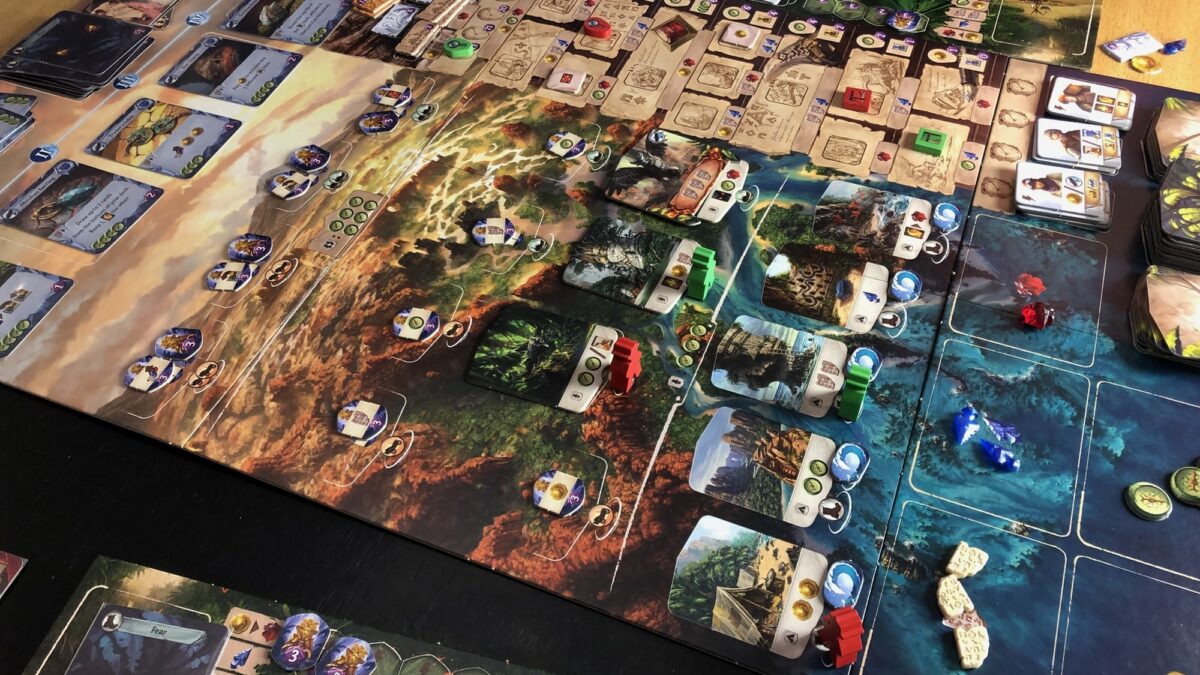I’ve been aware of Lost Ruins of Arnak being popular. A friend even offered his copy on loan at one point. I said no, because I wasn’t keen on learning new games, and we were busy playing Anno 1800 and Hallertau anyway.
Now, another long-time gaming buddy showered praise on Arnak on an online forum, and I thought the game might be worth a closer look after all. Thus the idea was born: here’s a splendid Christmas present for Nooa, who, after all, likes new games a lot. My reluctance towards new games has also meant he hasn’t been exposed to new games as much as he might want to.

Arnak proved to be a success, and better than I expected. We’ve already played the game ten times in less than a week. Half of these plays have been two-player games with Nooa and the other half four-player games. We went to visit my mother, and I brought Arnak with us – I thought maybe there’d be a chance for Nooa and me to play it, but it turned out my mother was in the mood for new games, and she roped in Anni, and off we went and ended up playing the game four times.
Arnak, being a Kennerspiel des Jahres candidate, is a decent match for my mother, but I wouldn’t have expected Anni to like it. Anni said so herself: she thought the game would be another stupid, too-complicated game, but after we played the first game where I held her hand a bit and helped her through the decisions, she realized she does like the game, and what’s best, she could then make her own decisions and do reasonably well in the game.
That has been one of the delightful sides of Arnak: it has always been a close game. As the scores go, I’ve heard 60–70 is a decent score, skilled players should hit 70+ every time, and getting to 80+ requires some more profound understanding. So far, we’ve been firmly in the 60–70 point range. The game has certainly felt like a failure if I’ve been below that.
The game is a combination of deck-building, worker placement and resource management. The critical feature in the game is the research track: there’s no question about that; you need to get to the top of that track. That’s just how the game works. Getting to the top requires many hard-to-get resources and everything else in the game is about how to get those resources.
The game is just five rounds, so typical Dominion-style deck-building won’t cut it. In the early game, you’re mostly buying item cards, which go to the bottom of your deck when you buy them. This means you’ll draw them the next round most of the time. Later in the game, you’ll be more interested in the more powerful artefacts, which you get to use immediately. Any cards you use are discarded. The discards are shuffled and added to the bottom of your deck. It’s all pretty clever.
The worker placement element is also tiny: you only have two workers. With those workers, you can take basic actions that are always available, but with only those actions, you’re never going to get enough resources. Fortunately, you can explore the board to open up new worker placements spots that offer rewards when you open them and provide more considerable benefits from your worker placements. The new sites are protected by guardians, which can be overcome to gain points and benefits.

All in all, this is a clever game that plays reasonably fast (the box says 30 minutes per player; 10–20 minutes per player has been our experience) and offers room for sufficiently deep strategic thought. I’m pretty sure there are thorough strategy guides on BGG; I’ve been avoiding them on purpose. There’s a lot to learn, considering it is possible to reach scores of over 100 points, a feat that seems impossible to me right now.
It’s not entirely without downsides. The theme is somewhat colonialistic in its Indiana Jones “here’s an ancient civilization, let’s loot it” vibe. It’s laced with fantasy, making it more palatable, but some might still find it offensive. Mechanically, it’s much more of a dry resource management puzzle than an exciting adventure, so someone lured in by the colourful theme may end up disappointed in how dry and optimization-heavy the game is. It’s very much about wringing every last bit from the limited resources you get. I find that fun, but many people don’t particularly enjoy that kind of game. The game also takes some work to set up and tear down.
Given that the game is beautiful to look at, I’m not at all surprised Lost Ruins of Arnak is one of the highlights of the 2020 crop for many. It is available both on Yucata and Board Game Arena for online play, so it’s easy to give it a go. If you’re looking for a medium-weight game, this one’s an easy recommendation.
